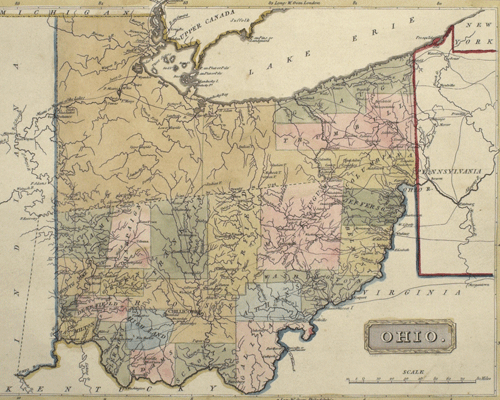Results navigation
2. Ohio 1816 Treasurer
3. Ohio 1816 Treasurer, Ballot 2
4. Ohio 1816 Treasurer, Ballot 3
5. Ohio 1820 Treasurer, Special
6. Ohio 1820 Treasurer, Special, Ballot 2
7. Ohio 1820 Treasurer, Special, Ballot 3
8. Ohio 1820 Treasurer, Special, Ballot 4
9. Ohio 1823 Treasurer
10. Ohio 1823 Treasurer, Ballot 2
Results navigation

In these years, Ohio changed from a virtually unpeopled frontier area within the Northwest Territory to the fourth most powerful state in federal elections. Its first significant elections were for the lower house of the Territorial Assembly in December 1798. Suffrage was restricted to adult males who owned fifty acres freehold (the most limited franchise in the nation), although Governor Arthur St. Clair extended the vote to those who owned town lots of comparable value. Voting took place viva voce at the county seat, under the supervision of men appointed by the governor, who also determined apportionment and could veto legislation and prorogue (postpone) and dissolve the Assembly. The upper house, the Council, was appointed by the president from a list of names drawn up by the house; Congress appointed the governor on the president's nomination. This authoritarian system was overthrown when Congress passed the Enabling Act of 1802, authorizing the calling of a convention elected virtually on the basis of manhood suffrage.
Ohio became a state in March 1803, operating under the constitution drafted in November 1802. That instrument gave little power or patronage, and no veto, to the governor, who was elected biennially. The all-powerful General Assembly was divided into two chambers: The House was elected annually by county constituencies, and the Senate was elected biennially, half the members each year, in districts made up of one or more counties. There were no property qualifications for membership in the Assembly. Every four years the state took a census of adult males and redistributed legislative seats, and congressional districts were reapportioned each decade immediately after Congress had reapportioned the federal House and electoral college. Beginning with the first presidential election in 1804, the electors were chosen by statewide popular vote. The right to vote was limited to white adult males who had been resident for one year and had paid a tax. However, because the state constitution defined compulsory work on the roads as a tax and all adult males between the ages of 18 and 55 were obliged to work on the roads (or buy a substitute), this amounted to a nearly all-inclusive franchise for white males. From the start, voting was by secret ballot, with ballots deposited in special locked boxes, and whereas under the territory, voters had had to travel to the few county seats to vote, people now voted at a central place in each of the rapidly multiplying townships.
This democratic electoral system produced elections that saw a surprising degree of partisan action and comparatively high—but fluctuating—voter involvement, especially after 1807 when the key elections began to coincide in even years. The Federalist predominance of the territorial period was overthrown in 1802—1803, and the then overwhelmingly dominant Democratic-Republican party soon divided along factional lines, notably over the role of the judiciary. In some parts of the state, the Federalist Party revived after 1807 but suffered a severe decline after 1816. As a consequence, nonpartisan elections became even more common, although old-party considerations operated in some local elections into the 1820s. In 1824 Ohio's first competitive election for the presidency saw turnout surge as voters began giving their allegiance to entirely new political formations.
Bibliography
Annual Report of the Secretary of the State to the Governor of the State of Ohio: including the statistical report to the general assembly for the year 1875. Colombus, OH: Nevins & Myers, State Printers, 1876. (Lists members of the General Assembly and their districts from the formation of the state)- Brown, Jeffrey P. and Andrew R. L. Cayton, eds.
The Pursuit of Public Power: Political Culture in Ohio, 1787–1861. Kent, OH: Kent State University Press, 1994. - Cayton, Andrew R. L.
The Frontier State: Ideology and Politics in the Ohio Country. Kent, OH: Kent State University Press, 1986. - Ohio Historical Society, Ohio Fundamental Documents Searchable Database,
http://www.ohiohistory.org/resource/database/funddocs.html - Ratcliffe, Donald J.
"Voter Turnout in Early Ohio," Journal of the Early Republic, 7 (1987): 223–251. Reprinted in New Perspectives on the Early Republic, ed. Ralph D. Gray and Michael A. Morrison. Urbana and Chicago: University of Illinois Press, 1994, pp. 269–297. - ________.
"The Mystery of Ohio's Missing Presidential Election Returns, 1804–1848," Archival Issues: The Journal of the Midwest Archives Conference, 17(2)(1992): 137–144. - ________.
Party Spirit in a Frontier Republic: Democratic Politics in Ohio, 1793–1821. Columbus, OH: Ohio State University Press, 1998. - ________.
The Politics of Long Division: The Birth of the Second Party System in Ohio, 1818–1828. Columbus: Ohio State University Press, 2000. - ________.
"The Changing Political World of Thomas Worthington." inThe Center of a Great Empire: The Ohio Country in the Early Republic , ed. Andrew R. L. Cayton and Stuart D. Hobbs. Athens: Ohio University Press, 2005, pp. 36–61. - Utter, William T.
The Frontier State, 1803–1825 , 1943 reprint ed. Columbus: Ohio Historical Society, 1968), Vol. 2 of Carl Wittke, ed., A History of the State of Ohio, 6 vols. Columbus: Ohio State Archaeological and Historical Society, 1941–1944.
Treasurer
One who has officially the charge of treasure; originally, a person entrusted with the receipt, care, and disbursement of the revenues of a king, noble, or other dignitary, of a state, city, or church; now, one who is responsible for the funds of a public body, or of any corporation, association, society, or club.
Oxford English Dictionary
1787 - 1824: Connecticut, Georgia, Kentucky, Maine, Maryland, Massachusetts, New Hampshire, New Jersey, New York, North Carolina, Ohio, Pennyslvania, Rhode Island, South Carolina, Vermont, Virginia
Office Scope: State / County / City / Town(ship)
Role Scope: State / County / District / City / Town(ship)






